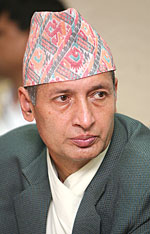 KIRAN PANDAY |
Nepali Times: Is the worst over?
Ajay Shrestha: The liquidity crunch since December was a result of over-aggression in lending, particularly in the real estate sector. Over-lending and all this was exacerbated by the shortage of currency notes, the withdrawal of deposits following the directive on declaration of assets. What is important is to learn our lesson from this. This wasn't an overnight phenomenon, the signs were there, and the banks were too late in reading it.
The Rastra Bank's intervention brought stability to the market by throwing a liquidity lifeline through REPO, but it isn't designed for long-term stability. In the long term we have to find ways to bring back deposits into the system and a more rational control over lending. After this year's rough patch we ourselves are in a consolidation phase, but we have a stable situation. Performance-wise it was never an issue.
So there is a light at the end of the tunnel?
We're not out of the woods yet. The core economic fundamentals are still not in good shape, there is a power crisis, GDP is stagnant, industrial production is not going up. The political fluidity is having a big impact on economic activity, the budget has not even been formulated. Government spending injects liquidity into the market.
Any chance of a recovery in the real estate market?
Real estate is stagnant, there is very little buying and selling taking place. There will always be a core demand for land and construction based on remittances. The inflow is still there, but it is being spent on assets, land and buildings. In the recent past it became a huge speculative bubble. Real estate was overplayed vis-�-vis demand. The only fear now is who will take that loss if the market comes back to its natural size: the seller, the buyer, the banks?
Is it going to be the survival of the fittest, then?
Survival now will depend on holding capacity. There will be growth and selling pressure and in the near future prices may appreciate. The realty market is caught between a demand-side push and supply-side push.
And other sectors?
The service sector is not doing too badly. Health, education and tourism require less capital and there is earning capacity. But industrial production has suffered because of the power crisis and labour problems. Infrastructure has potential but it has a lengthy gestation period. Hydropower projects are suffering from the interest rate hike because it was not a risk factor during the feasibility studies. With the power purchase agreements done, and only a fixed revenue source, it is a Catch-22 situation. Projects already in the pipeline will probably go through but new hydropower projects will be delayed. Bank of Kathmandu doesn't have much exposure in the real estate market, it is lending mainly to the service sector, and it was one of the first to lend in hydropower as part of a consortium supporting the Piluwa project.
What is your future strategy?
The real challenge now is reorient ourselves from lending to deposits. The strategy has to be to bring the households outside the Valley into banking and turn them from consumers to savers. We launched our 'Save for the Future' campaign five months ago.
Glass half-full
 |
The Nepal Rastra Bank (NRB) governor certainly seems to think so.
Yubaraj Khatiwada said at a seminar last week that depositors were returning to banks, attracted by higher interest rates. This has reduced the inter-bank lending rate by up to 3 per cent, and on T-bill rates, which could also translate into a lowering of interest rates on loans.
"The rise in interest rates on deposits is one of the main factors for the favourable cash situation," Khatiwada said. He was also encouraged by Nepal's healthier balance of payments, and now wants to achieve an ambitious BoP surplus of Rs 9 billion. He thinks this can be done because of healthier tourism receipts, and a firming up of remittances following a slowdown in growth earlier this year.
Although the banking sector is encouraged by these trends, they are hedging their bets, and there is residual nervousness in the market. Banking sources estimate that deposits in banks have soared by Rs 40 billion in the last three months, but half of this is said to be the result of government spending ahead of the end of the fiscal year.
Many smaller private banks are still reeling under a decline in profitability caused by the drop in loans due to the higher interest rates. The liquidity crunch also affected their loan disbursement portfolios. "Any lowering of lending rates by private banks is not going to happen before Dasain," confided one bank executive.
Most businesses have failed to be enthused by the Monetary Policy and early signs of recovery. The main reason is the political instability that has delayed the budget and the laying out of the country's fiscal policy.
READ ALSO:
Mega goes for megawatts and more
Bogged down
Who implements?, SUBRATH SHRESTHA


